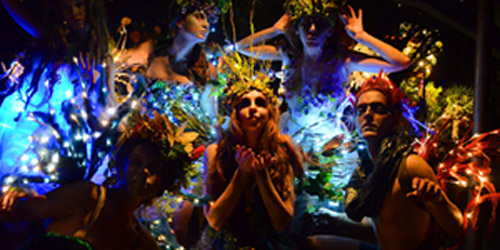Fairy Worlds! – A Review

Members of the Southwest Shakespeare Company are in the midst of their run of their rendition of A Midsummer Night’s Dream, Fairy Worlds!
May 28, 2014
Last Saturday I attended Fairy Worlds!, a rendition of A Midsummer Night’s Dream by the Southwest Shakespeare Company performed outdoors in the Desert Botanical Garden. I was completely taken away by the play; I’ve attended other performances by the Southwest Shakespeare Company and I have always been impressed by the caliber of their acting and technical skill; this performance was no different. Although the play wasn’t perfect– and no performance is truly perfect– I left with an extremely positive impression of the play, and I would highly recommend this show to everyone. It doesn’t matter if you’re old or young, a diehard Bard fan or new to Shakespeare altogether; the SSC put on a show that is sure to entertain.
For those of you who are new the story of A Midsummer Night’s Dream, it basically goes like this: love triangles. Love triangles and fairy mischief out the wazoo. You have a variety of characters in or out of love, several of them under the influence of spells and charms that misdirect their affections. There are two primary conflicts, one being that the fairy queen Titania and her husband Oberon are having marital disagreements. This has led to imbalances in nature, such as floods and rampant disease spreading through the air. The second conflict is between four lovers; Hermia and Lysander are deeply in love, but Hermia’s father disapproves of the relationship, and wishes for Hermia to marry Demetrius. There is a fourth character, Helena, who loves Demetrius and is spurned by him, in favor of Hermia. Just to try to make that tangled mess a bit clearer: Lysander and Hermia are in love, but their relationship is not allowed; Demetrius wants Hermia and is approved to marry her, but she rejects him; Helena is in love with Demetrius, but he doesn’t want her. Got it? The story starts when Hermia and Lysander run away into the woods in order to elope, and are pursued by Demetrius, who in turn is followed by Helena. Once they enter the woods, the couples fall victim to fairy tricks, eventually leading to both men being in love with Helena instead of Hermia. There is also a subplot involving the “builders,” a group of construction men who are trying to rehearse a play; these comical characters end up directly involved in the conflict between Oberon and Titania.
Most folks have a hard time interpreting Shakespeare, but the SSC has always been great at making the writing understandable to modern viewers. This show was the same; through useful gestures, inflection, and proper acting and reactions, the audience is let in on all the jokes and plot twists that make A Midsummer Night’s Dream a great comedy. The acting skill of all the performers was very strong. It was clear that each actor had taken the time to learn their character’s voice, body language, and mannerisms. I had a seat close to the stage, and I was impressed with the way that everyone had adopted their respective characters. Even in low lighting, or when the actors were obscured by stage fog, it was easy to identify characters just by the way they moved. There were a variety of interesting costumes; the fairies had particularly interesting costumes. In addition to a smothering of plants and flowers woven into their clothes and hair, they had skirts and wings decked out with lights that made them highly visible on the stage, and in the audience when they sat out amongst the seats. The show had a lot of attention devoted to lighting, from the fairy costumes, to the dramatic lighting onstage, to the lights around the stage in the garden. I have to say that I was little disappointed with the lighting offstage, as well as the position of the stage. The show was advertized to make it sound as if the show was taking place within the actual garden, surrounded by the desert plants. This was not the case, as the stage was actually set up outside of the garden, in a dirt lot. There were some trees and tall cacti behind the stage which were highlighted and dramatically lit during certain scenes, but ultimately there was no real plant life showcased during the show.
The biggest issue with the show were all of the technical gaffes. The performance was plagued by sound difficulties all throughout; the character Helena in particular fell victim to many instances when her mic cut out, often in the middle of monologues. The technical difficulties were so severe that the show even had to be paused right in the middle of an act, with all of the characters already onstage, while the tech crew adjusted the electronics backstage. However, the technical issues did not take away from the show, thanks to the quick and effective recovery of the actors. Helena never flinched when her microphone cut out, and continued her lines in a strong, projected voice, so that the audience members sitting far away would still be able to hear. During the surprise “intermission,” the fairies onstage froze for a few minutes, before some of the actors decided to continue entertaining the audience. Two fairies in center stage goofed around and had a mock fight, while other fairies on the side of the stage pretended to be engrossed in conversation, or relaxing. One flexible fairy displayed amazing grace and coordination as she slowly and delicately performed acrobatic chin stands. The show always went on, and did not diminish in quality because of the technical problems.
The quality of the performance was really a product of its actors. By day, Aimee Blau teaches a writing class at ASU, but on the side she acts with the Southwest Shakespeare Company. Blau says that while it’s different to act on an outdoor stage, it isn’t much harder than performing inside. There is weather, heat, and ambient noise, but Blau (who has never performed outdoors before) says that she didn’t find it especially difficult. According to Blau, the most challenging part of this show was the costumes. The actor played one of Titania’s fairies, and she says that the fairy wings and other costume parts weigh a lot more than their usual adornments. The actors had to spend a lot of time practicing in the costumes, learning how to hold their weight and move around. Bobby Shook, who played a part as one of the builders, feels that the most difficult part of the show was managing all of the electronics. Shook has performed frequently in outdoor theater in the round, which is very low tech; this performance is comparatively crazy with electronics and tech. However, Shook loves “spectacle,” and he says that this show can produce that effect better with all of the electronics that it uses. The actors did not spend a lot of time doing tech rehearsals. In fact, the outdoor stage itself was only fully completed a few hours before opening night, the night before the performance I attended. Shook and Blau agreed that the show came together very quickly in the end.
There are still more show dates extending through March, with the last show landing on June 1st. If you have the interest or opportunity, I highly recommend going to see the show. The Southwest Shakespeare Company is truly a master at bringing the Bard into the modern world, and putting on a show that is enjoyable for everybody. Be quick, though– the show I went to was sold out, and future performances might be packed! Act fast, and get your tickets to see this wonderful rendition of a classic Shakespearean comedy.











